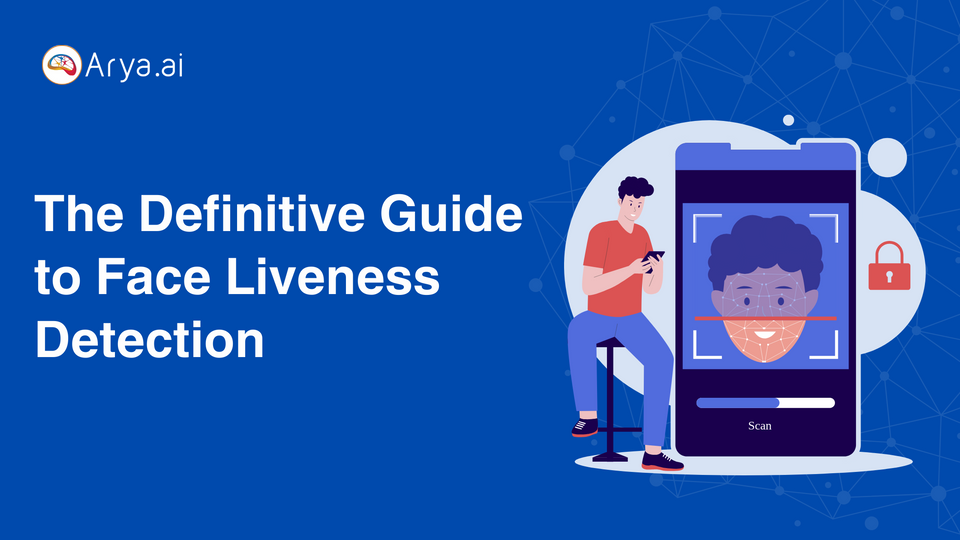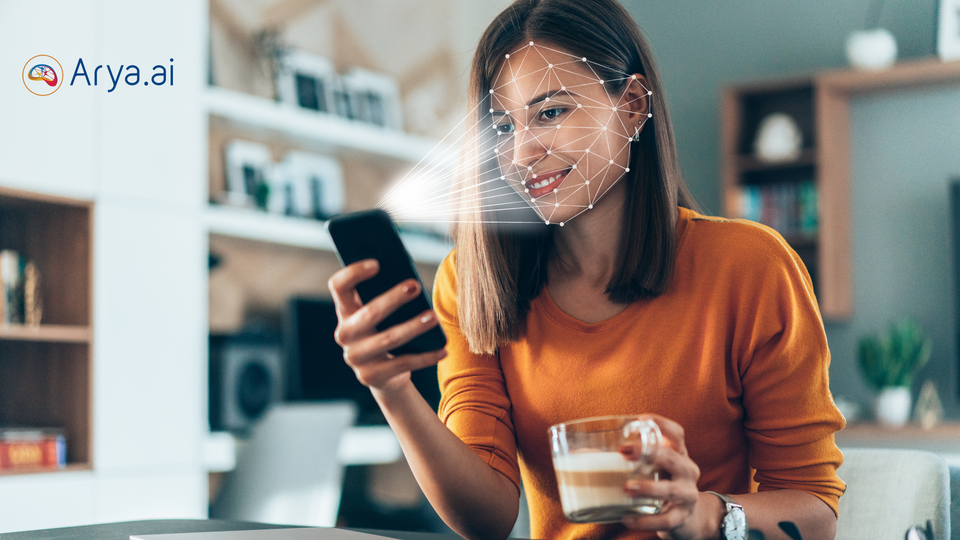While biometric authentication systems, including voice and facial recognition, are known to improve a company’s security by preventing unauthorized access, hackers can still trick and spoof them to bypass security systems.
With the rapidly advancing technology and Artificial Intelligence (AI) solutions, hackers can now easily create a digital human-face replica or high-quality 3D fingerprints to gain malicious access to systems or company networks.
This is where liveness detection comes into play. According to the 2023 State of Deepfakes report by Home Security Heroes, the total number of deepfake videos increased by 550% between 2019 and 2023.
This signifies the increasing deepfake concerns and the importance of liveness detection in ensuring effective user identification and securing user identities across sectors like banking, access controls, and mobile payments.
This blog dives deep into understanding liveness detection, how it works, its types, and its role in securing industries today.
What is Liveness Detection?
Liveness detection is a security technology that detects and verifies the user’s captured biometric data, such as fingerprints, facial scans, or iris scans, to confirm whether this data came from a genuine, living person or from a spoofed attempt.
So, while two-factor and multi-factor authentication solutions add a second layer of security towards user authentication, liveness detection goes a step further and adds an additional third layer of security- minimizing the risks of spoofing and unauthorized malicious access.
It employs algorithms that help identify inconsistencies that indicate manipulative behavior to validate the biometric data’s authenticity and prevent impersonation or risks of identity theft.
Types of Liveness Detection Systems
Based on the input required from the end user, liveness detection is classified into three main types: active, passive, and hybrid liveness detection.
1. Active Liveness Detection
Active liveness checks require the user to perform specific actions, such as turning their head, eye blinking, raising eyebrows, smiling, nodding up and down, etc., to undergo biometric verification.
By capturing and analyzing these gestures, the liveness detection API verifies whether the user is physically present for biometric verification- differentiating the user’s gestures from spoofs or artificial representations.
However, this type of liveness detection has its own cons, such as the fact that it takes time to perform or pass the authentication, making it inconvenient for the user to perform authentication in public, and user involvement may lead to higher abandonment rates.
2. Passive Liveness Detection
Unlike active liveness detection, passive liveness detection requires no interaction. It detects and verifies the user’s presence while authentication- without the user making explicit gestures or actions.
It uses and analyzes fixed-length facial video or imagery of the user to analyze properties such as skin texture, light, micro-motions, and other critical and minute characteristics to determine the user's presence.
Passive liveness detection is more beneficial and convenient as it provides an additional security layer and ensures secure biometric authentication- without direct user interaction.
3. Hybrid Liveness Detection
Hybrid liveness detection combines passive and active liveness checks, creating a comprehensive and robust authentication system.
In this method, the detection API shifts to an active liveness check if the passive data is insufficient. This amalgamation of the two liveness checks enables accuracy in detection-making it effective in preventing spoofs and fraudulent attempts.
How does Liveness Detection work?
Liveness detection uses sophisticated AI algorithms to differentiate between the real human user and spoofs or deepfakes. It typically involves a user taking a selfie or uploading a photo during the identity verification onboarding.
Depending on the type of liveness detection, this process takes two to a few seconds. Active liveness detection takes slightly longer than passive liveness detection.
Here are the different components and technologies contributing to the working of liveness detection processes-
Facial liveness analysis:
Liveness detection often starts with facial detection and recognition. This focuses on capturing and analyzing the user’s facial features, expressions, and micro-movements from the provided video or image for biometric data authentication.
Motion-based detection:
Motion analysis involves the user performing specific actions, like smiling, blinking, or nodding their head. The liveness detection system analyzes these dynamic gestures and movements to ensure they are lively, consistent, and align with the user’s live behavior.
3D imaging or depth perception:
Assessing depth perception is one key aspect and nuanced approach to liveness detection systems. While traditional 2D images lack depth, liveness detection systems use 3D depth mapping or depth-sensing cameras to analyze the user’s spatial information of facial expressions.
Blood flow and heartbeat detection:
Liveness detection systems analyze fingerprints or facial recognition to observe minute color changes linked with blood flow. At the same time, they can also detect the user’s heartbeat with the blood flow shift—signifying that the biometric data comes from a real live user.
Color and texture analysis:
By examining the texture and color patterns on the user’s face, liveness detection systems ensure that the data exhibits realistic human characteristics—adding an additional layer of security to the biometric authentication system.
AI and ML algorithms:
Liveness detection systems use AI and ML algorithms to learn and adapt over time. With the growing dataset, liveness detection systems automatically adapt to the alteration of an authorized user’s facial features, like the growth of facial hair or glasses, improving accuracy and refining biometric authentication.
Eye movement and pupil dilation:
Monitoring aspects like changes in pupil size or eye movement in response to light stimuli distinguishes a living person from a static 2D image.
Importance of Face Liveness Detection in Identity Verification
With the growing number of deepfake and spoofing incidents and challenges, implementing face liveness detection becomes critical to strengthening overall security.
Here’s how face liveness detection technology helps banks and financial institutions secure identity verification and develop a higher level of trust.
1. Enhanced security
Liveness detection significantly improves security by preventing presentation attacks or spoofing attempts.
It helps banks and businesses ensure that unauthorized users don’t slip through using manipulative images or videos and, instead, verifies that the user attempting to log in is physically present- preventing security risks and impersonation.
2. Streamlined identity verification
While imposters try to employ sophisticated measures to deceive the biometric authentication system, face liveness detection employs technologies like 3D face analysis and depth perception to secure and streamline identity verification.
Besides, it also optimizes the verification process with quick and instant identity proofing- without requiring the user to upload physical documents or perform extra verification checks.
This real-time verification process reduces waiting time and enhances user experience- especially beneficial during online transactions for eCommerce businesses and banks, where users can employ a facial scan to authenticate payments- providing a seamless user experience.
3. Fraud prevention
Fraud prevention is one of the primary objectives of face liveness detection.
By verifying the user’s authenticity and live presence during the biometric authentication process, liveness detection systems significantly reduce the risks of fraud and malicious activities.
4. Improved accuracy
Since liveness detection systems verify and confirm that genuine users are attempting to log in or access the system- it enables a secure onboarding and enrollment process by storing genuine and reliable biometric user data.
This improves data accuracy and trustworthiness within the system, also eliminating the chances of false positives.
5. Cost-efficient
By integrating face liveness detection, organizations such as banks, hospitals, and governments can significantly reduce costs related to manual identity checks and tools for extra security measures.
This streamlined method of identity verification enables financial institutions to efficiently process more verification data, saving time, effort, and resources.
Besides, it helps banks and organizations save or reduce the money they would lose to security breaches or fraud had they not integrated liveness detection in place.
6. Protection from deepfakes and identity theft
Identity theft protection is another major benefit of liveness detection.
By adding a robust security layer to biometric authentication, face liveness detection distinguishes between fraudulent imposters adding 2D or 3D printed images and real human presence, protecting users' data and identities from being compromised.
Moreover, face liveness detection models can also differentiate between individuals like identical twins with closely resembling features and adapt to the user’s facial changes, like facial hair growth- ensuring authorized user access and preventing chances of deepfakes.
7. Improved customer trust and convenience
Face liveness detection eliminates the need for users to undergo additional steps during biometric verification or provide details like passwords or security information- offering a seamless and convenient user experience.
Users can quickly perform identity checks by capturing their live faces through facial scans, enhancing customer convenience.
At the same time, financial institutions and organizations can demonstrate using secure and reliable liveness detection systems, which builds customer satisfaction and trust in the institution- beneficial for building long-term customer relationships.
8. Compliance with regulations
Liveness detection systems align with industry standards and compliance and regulatory requirements for secure identity verification.
This helps organizations and financial institutions comply with anti-money laundering (AML) and know-your-customer (KYC) obligations, reducing legal and reputational risks and ensuring compliance.
Industries That Benefit From Liveness Detection
Liveness detection benefits not just one sector but multiple industries—helping them prevent fraud and streamline biometric authentication.
Here are the applications of liveness checks that safeguard different industries:
- Finance and banking industry: Liveness detection streamlines identity verification during online and mobile banking transactions. It enables secure access control for banks, improves customer experience, and reduces risks of deepfakes and fraudulent attempts, securing sensitive customer and banking information. Explore how financial companies are using Liveness Detection for an enhanced experience.
- Healthcare industry: The healthcare industry uses liveness detection to authenticate patients before accessing sensitive data or medical records. It enables the healthcare industry to identify patients accurately, enhance patient safety, streamline administrative processes, and prevent medical identity theft.
- Law enforcement: Law enforcement agencies and border control authorities use a liveness detection system to identify and track individuals involved in criminal activities. This helps in quicker suspect detection, faster crime resolution, and enhanced public safety.
- Travel and transportation: In the travel industry, train stations and airports use liveness detection to authenticate and verify individuals during ticketing, security checks, and boarding. This significantly prevents unauthorized access to transportation services.
- Government agencies: Several government agencies can use liveness detection to authenticate citizens applying for services such as tax filing, official document applications, and social welfare programs.
Choosing the Right Liveness Detection Solution for Your Needs
Several factors must be considered when choosing the right liveness detection solution to maximize benefits and security.
Here are the key factors you must consider when looking for an ideal liveness detection that meets your needs-
1. Know the primary reason behind choosing liveness detection:
The first step is to identify the primary objective behind deploying liveness detection. Determine whether your goal is to prevent fraud, enhance security, comply with regulations, or improve user experience, and choose a solution accordingly.
2. Evaluate reliability and accuracy:
An ideal liveness detection solution should provide higher reliability and accuracy when differentiating between spoofed attempts and a live individual. It’s critical to consider solutions that leverage advanced AI and ML algorithms to ensure enhanced accuracy.
3. Analyze user convenience:
Choosing a liveness detection solution that seamlessly integrates with the existing system and ensures minimal friction during user authentication is important. Also, considering the system’s processing speed and ease of use is crucial to ensure a seamless user experience.
4. Analyze flexibility and scalability:
A good liveness detection solution should efficiently accommodate the growing and evolving future needs and adapt to the institution’s changing requirements, like expanding to new markets, increasing user volumes, and other system integrations.
5. Cost and ROI:
Evaluating the system’s cost-effectiveness is important based on your organization's budget constraints and expected return on investment (ROI). You can consider factors such as maintenance expenses, upfront costs, and savings from potential fraud.
6. Vendor support and reputation:
Researching the liveness detection solution's reputation and previous track record is paramount. Choose a liveness detection solution vendor with a history of good customer support, reliability, high-quality results, and ongoing updates and maintenance to accommodate the growing needs.
Need help choosing the right partner? Make the right decision for your business
Why Choose Arya AI’s Passive Face Liveness Detection API?
Choosing a highly reliable liveness detection system that can distinguish between a spoofed and real user plays a crucial role in ensuring an organization’s and user's security.
This is where our Arya AI’s API stands out. Our Passive Face Liveness Detection API works on any image provided to authenticate and verify the user's identity. Here are the key features of our API that make it a prime choice for banks and organizations when looking for a liveness detection solution:
- Analyzes any given image to determine whether the individual in it is present during the authentication process- significantly enhancing security and reliability.
- It ensures user convenience by executing the verification process in the background without requiring them to indicate it or make an additional effort—enabling smooth onboarding and minimizing customer drop-offs.
- Enables frictionless authentication that takes less than a second to determine spoofs or identity thefts.
Face liveness detection is crucial for organizations and financial institutions to prevent evolving deepfake attempts, spoofing, and fraudulent unauthorized access.
Using advanced AI and ML algorithms, liveness detection solutions streamline biometric authentication, strengthen security, ensure regulatory compliance, and boost customer experience. By employing liveness detection in the existing systems, companies can stay ahead of the competition, mitigate cybersecurity risks and breaches, and secure customer data and critical business information.
So, choose a reliable liveness detection solution and enable secure user verification for your business or financial institution.





